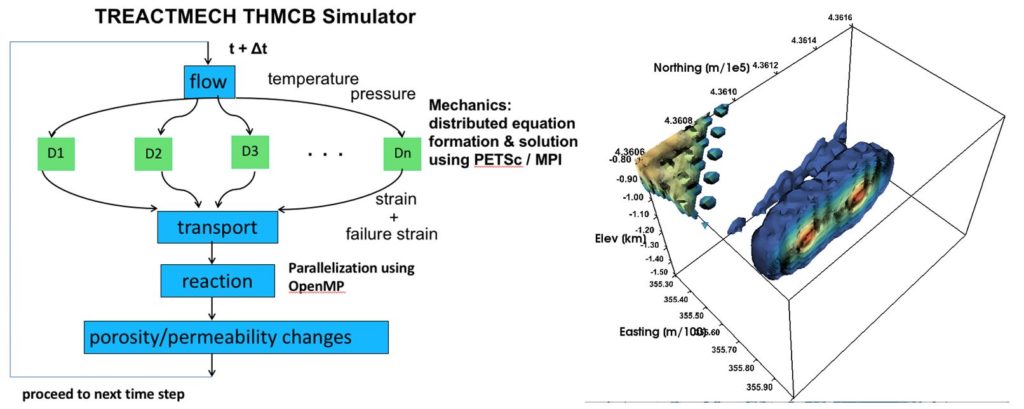TReactMech introduces a parallel coupled continuum geomechanics capability into the thermal-hydrological-(biogeo)-chemical (THMCB) parallel simulator TOUGHREACT V4.13-OMP (Sonnenthal et al., 2014; 2017; Xu et al. 2011; 2006), with improvements to the TOUGH2 multiphase flow core (Pruess et al., 1999). The geomechanical formulation is based on a 3-D continuum finite-element model with full 3-D stress calculations, plastic deformation via shear and tensile failure (Kim et al., 2012; 2015; Smith et al., 2015). Applications of TReactMech to Enhanced Geothermal System stimulation modeling and THMC experiments on rock cores are presented in Sonnenthal et al. (2015, 2018), Kneafsey et al. (2016, 2017).
TReactMech is ideally suited for continuum representations of fractured and porous rock masses at scales of meters to tens of kilometers. However, TReactMech can also simulate processes at the scale of individual fractures, such as for simulating hydraulic fracturing, or single-fracture deformation at the core-scale. The continuum model approach considers local (grid-block scale) averaging of fracture porosities, permeabilities, and other properties, in comparison to discrete fracture models (DFM) that capture fracture aperture changes typically using statistical realizations of fracture size distributions and orientations.
In TReactMech, heat and fluid flow, stress, and reactive transport are solved using the sequential non-iterative approach, as shown below. Fluid flow and heat transport are solved simultaneously as in TOUGH2 (Pruess et al., 1999) with modifications to consider multiple coupled geochemical and geomechanical effects on porosity and permeability, as well as new capabilities such as temperature-dependent thermal properties. TReactMech uses a hybrid parallel computation approach, in which the geomechanics are solved using Petsc/MPI and the reactive chemistry with OpenMP. Geomechanics (3D stress equations, strain and failure strain) are solved after fluid and heat flow, followed by transport of aqueous and gaseous species, mineral-water-gas reactions, and finally permeability-porosity-capillary pressure changes owing to geomechanical and geochemical changes to porosity (or fracture aperture).

Want to learn more about TReactMech? Register now for the Short Course happening in October!